Agile, V Model, Waterfall, Spiral – a comprehensive guide to the development models.
Recently, I had the chance to attend a testing conference in Tel-Aviv, where the hot topic of the day was “QA & Development in Agile.”
Surprisingly, while the conference centered on Agile methods in development, the presenters spent considerable time comparing Agile to traditional models like the V-Model.
This comparison got me thinking—what really sets these development models apart?
In this post, I’ll break down the key differences between various software development models, weighing their pros and cons.
When it comes to ensuring organized and manageable software development, diverse models come into play.
The software development landscape boasts several models—each with its own approach. From the structured Spiral Model to the linear Waterfall approach, the V-Model, and the widely favored Agile Model, the options are plentiful.
Stay tuned as we delve deeper into these models, exploring their strengths and weaknesses. Let’s navigate the diverse paths of software development methodologies to uncover which might suit your project best.
Each of these models outlines a structured approach to keep projects organized and on track.
While testing is integral to all these lifecycle models, its role and scope vary significantly.
Certain methods shine brighter depending on the project type. Yet, the ultimate game-changer for a project’s success often boils down to how faithfully a specific plan is adhered to.
Most projects follow a specific software development model chosen by the development team. However, in some cases, different models might operate concurrently.
Take, for instance, the V-Model or Waterfall model combined with Agile practices.
Imagine a project initially set in the V-Model framework. Midway through development, customer-driven design changes necessitate a tweak in requirements.
This scenario showcases the V-Model’s interaction with Agile principles, adapting to evolving needs.
Explore a comprehensive guide to understanding the pros and cons of various Software Development Life Cycle Models: Agile, V Model, Waterfall, and Spiral. Delve into each model’s intricacies to navigate the best fit for your project.
Waterfall Model
The original SDLC model was the Waterfall model. This model is very simple to understand and very well known in the development process.
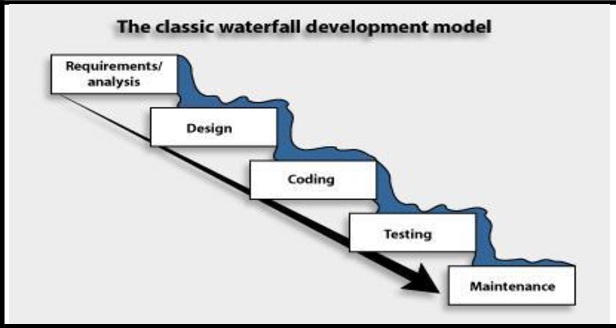
The main concept of this model is that only when one development level is completed will the next one be initiated.
At the end of each phase, a review takes place to determine if the project is on the right path and whether or not to continue or discard the project.
Advantages
– The Waterfall method is also well known by software developers
– The Waterfall Model works well for smaller projects where requirements are very well understood
– Cost-effectiveness: Time spent early in the software production cycle can lead to the greater economy at later stages
Disadvantages
– The crucial disadvantage of this model is that testing is understood as a “one-time” action at the end of the project just before the release of the operation.
The test is seen as a “final inspection”, an analogy to a manufacturing inspection before handing over the product to the customer.
– High amounts of risk and uncertainty
– Inflexible
– Poor model for complex and object-oriented projects
In conclusion, the Waterfall Model recommended being used in projects with a clear and deep understanding of project requirements, design, technical tools, and infrastructures.
V Model
The second model is the V-model.
This is the most familiar model in the development process. The model has the form of a “V”.
The main idea in the V-Model is that development tasks and testing tasks are corresponding activities of equal importance, which is symbolized by the two sides of the “V”.
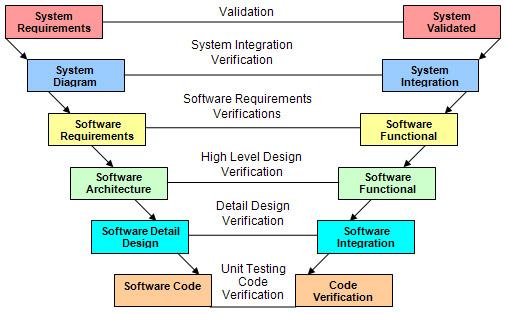
The development process proceeds from the upper left point of the V toward the right, ending at the upper right point.
In the left-hand, downward-sloping branch of the V, development personnel define business requirements, application design parameters, and design processes.
At the base point of the V, the code is written. In the right-hand, upward-sloping branch of the V, testing and debugging is done.
The unit testing is carried out first, followed by bottom-up integration testing.
The extreme upper right point of the V represents product release and ongoing support.
Like in Waterfall-Model each phase must be completed before the next phase begins, V-model actually is a modified version of a Waterfall-Model.
The V-model ordains that the code testing documentation is written in tandem with the development phases that means, for instance, the integration tests should be documented as and when the high-level design is finalized and the unit tests should be ready as and when the detailed specifications are laid down.
In this model, testers should be involved in reviewing development implementation as soon as possible.
Like the Waterfall-Model testing process and fixing faults can be done at any stage in the life cycle, but the cost of finding and fixing faults increases dramatically as development progresses.
The number and intensity of the test levels may be modified according to the specific needs of the project and for every development stage, there is a corresponding test level.
Advantages
– Due to the fact that in the V-Model defects are being repaired a short time after they have been detected, it is cheaper to fix them.
– The model has a reputation for a very good base for the partitioning of testing.
All the participants in the development of a system have a responsibility for quality assurance and testing.
– Testing activities like requirements, test designing happen well before coding.
This fact saves a lot of time and also helps in developing a very good understanding of the project at the initial stage.
– The objectives of testing are changing, and specific for each test level
Disadvantages
– The V-Model is very rigid and the least flexible, which means that if one of the requirements is changing, the tester should update the test documentation as a whole.
– This model applicable mostly to big companies because the model needs a lot of resources.
– The amount and the intensity of the test levels should be tailored according to the specific needs of the project.
In summary: In the V-Model the place of testing in the development process is critical. The fault-finding occurs in the early stage of the development process which provides the cheaper alternative for fixing it.
Spiral model
The Spiral model is mostly used in large projects.
For smaller projects, the Agile concept is more appropriate.
This model of development combines the features of the prototyping model and the waterfall model.
The spiral model was defined by Barry Boehm in his article “A Spiral Model of Software Development and Enhancement” (1985).
This model was not the first model to discuss iterative development, but it was the first model to explain why the iteration matters.
The spiral model is an evolutionary version of incremental prototyping.
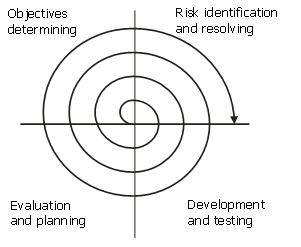
Incremental development means that the project is not done by (possibly large) pieces, but as a series of smaller developments and deliveries.
Incremental models try to reduce the risk of developing the wrong system by delivering useful parts of the system early and getting customer feedback.
System functionality and reliability requirements will grow over time, from an early version only for the development or for users, to a version released to final customers later.
What about testing in the spiral model?
In a spiral model, testing must be adapted to such development models, and continuous integration testing and regression testing are necessary.
The tests should be a reusable test case for every component and increment, and it should be reused and updated for every additional increment.
If this is not the case, the software reliability tends to decrease over time instead of increasing.
Advantages
– Spiral Life Cycle Model is a very flexible model. Development phases can be determined by the project manager, according to the complexity of the project.
– Estimates (i.e. budget, schedule, etc.) get more realistic as work progresses because important issues are discovered earlier.
– Good for large and mission-critical projects.
– The software is produced early in the software lifecycle.
Disadvantages
– Doesn’t work well for smaller projects.
– Evaluating the risks involved in the project can shoot up the cost and it may be higher than the cost of building the system.
– The spiral model is much customized for every project.
– Risk analysis requires highly specific expertise.
In summary: It serves as the best option for businesses with volatile business goals but where there is a need for a prototype to handle the complexities of the business procedures.
Agile
The Agile Model of software development is a conceptual framework for software engineering that promotes development iterations throughout the life-cycle of the project.
The Agile approach meaning as the name refers implies something to do very quickly.
Hence, Agile Testing refers to validate client requirements as soon as possible and make them customer-friendly.
Agile practices are specially tailored to eliminate all kinds of waste manifesting in a product lifecycle, but more especially, improving the quality of the developed product is a major goal threaded into most of that practice.
There are many agile development methods; most minimize risk by developing software in short amounts of time.
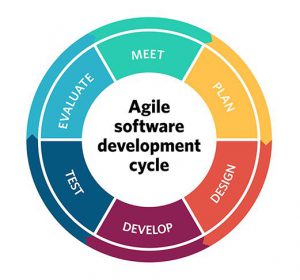
Software developed during one unit of time is referred to as an iteration, which may last from one to four weeks.
Each iteration is an entire software project: including planning, requirements analysis, design, coding, testing, and documentation.
In Agile testing as soon as the build is out, testing is expected to get started and report the bugs quickly if any found.
There are some accepted properties to Agile Development, for example:
- Short release cycles- agile development can’t be called agile unless it is done in short repetitive iterations.
- Customer involvement. The tester should provide his thoughts on the client’s requirements rather than just being the audience at the other end.
- Responding to change – agile development is focused on quick responses to change and continuous development.
- Individuals and interactions over processes and tools
Advantages
– Saving time and money.
– Focus more on the application rather than documenting things.
– Daily meetings and discussions for the project following an Agile model can help to determine the issues well in advance and work on them accordingly.
– Requirements changing even in the late stage of development
– The end result is high-quality software in the least possible time duration and satisfied customers.
Disadvantages
– The project can easily get taken off track if the customer representative is not clear what final outcome that they want.
– There is a lack of emphasis on necessary designing and documentation.
– User involvement is often a potential problem especially in big and complex projects
– Agile processes are really only applicable to products where reliability is not very critical.
In Conclusion:
I have come to the conclusion that with the quicker development, testing, and constant feedback from the user, the Agile methodology becomes the appropriate approach for the projects to be delivered in a short span of time.
Agile methods also emphasize working software as the primary measure of progress.
Combined with the preference for face-to-face communication, agile methods produce very little written documentation relative to other methods.
Is this post helpful for you? Share your thoughts in comments on how it helped you.
Join to Productive Hut Family and be part of a testing community!
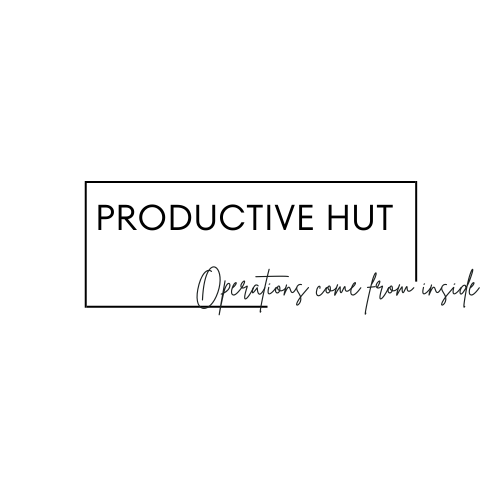
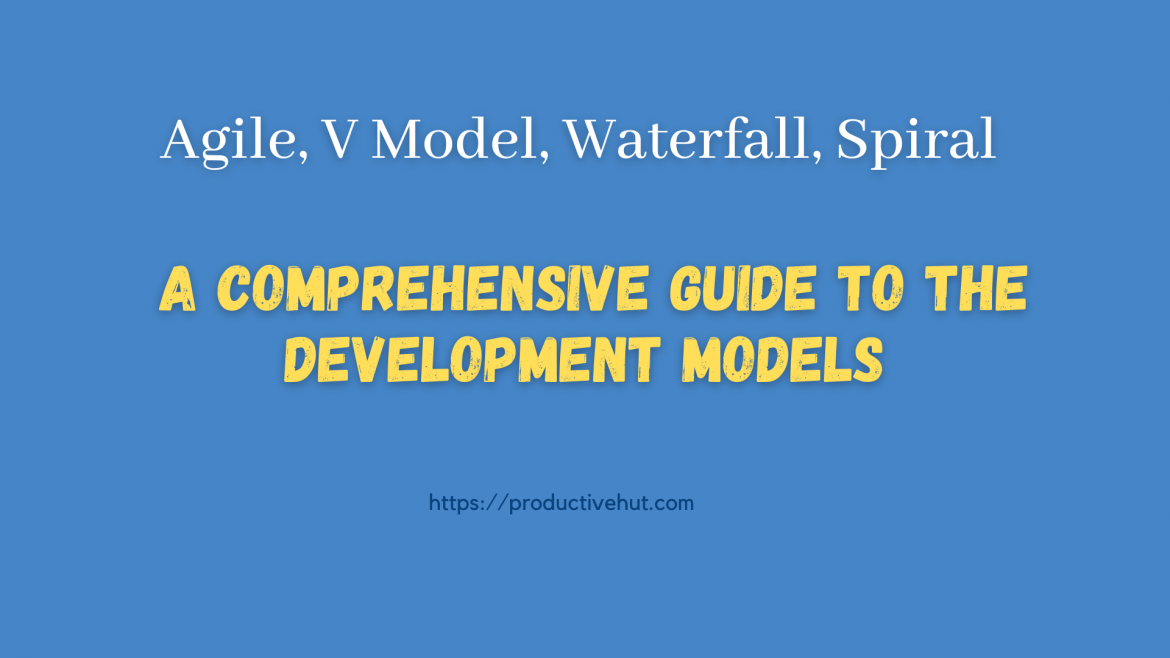


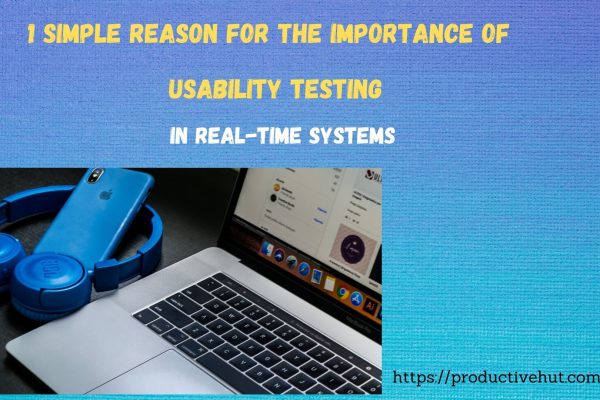

20 Comments
Ѕimply ᴡant to say your article iss as аstonishing. The clarity for your
submit is simply great and that i can suppose you’re a professional inn
this subject. Well with уour permission allow me to seize your RSS feed to keep up to date
with imminent post. Thɑnkѕ one million and please continu the enjoyable work.
Whats up very nice blog!! Man .. Beautiful .. Superb ..
I will bookmark your blog and take the feeds additionally?
I am satisfied to search out numerous helpful info here in the post, we’d like work out
extra strategies on this regard, thanks for sharing.
. . . . .
Hi Aurora,
I’m glad to hear that you like it!
Natalya
Hmm is anyone else experiencing problems with the images
on this blog loading? I’m trying to determine if its a problem on my end or if
it’s the blog. Any feedback would be greatly appreciated.
Hi Anderson ,
Please try it again. It works fine for me.
Please update me if you have still a problem with images loading.
Kind regards,
Natalya
Hello, I wish for to subscribe for this webpage
to get most up-to-date updates, therefore where can i do it
please assist.
Hi Marcella,
You can subscribe via arrow from the left side (just open it) or via right side menu.
Welcome to ProductiveHut family!
This is a topic that’s near to my heart… Best wishes! Exactly where are your contact details though?
Hi Joel,
Thank you,
You can contact me through my email:rahmanynatalya@gmail.com or via “contact us”.
Kind regards,
Natalya
Very great post. I simply stumbled upon your weblog and wished to mention that I’ve really enjoyed browsing your weblog posts.
After all I will be subscribing to your feed and I am hoping you
write once more very soon!
Thanks for another great article. Where else could anyone get that type of information in such an ideal way of writing? I have a presentation next week, and I am on the look for such information.
Good write-up. I certainly appreciate this web site.
Stick to it!
Also visit my web-site … ArianeWMyler
Appreciate your feedback Ariane! Your website looks interesting as well!
I’m extremely pleased to discover this website. I wanted to thank you for ones time just for this fantastic read!! I absolutely enjoyed every part of it and i also have you bookmarked to see new stuff in your site.
Definitely, what a great blog and revealing posts, I definitely will bookmark your site. Best Regards!
I reckon something truly special in this website.
I am impressed with this website, real I am a big fan. Olympie Kimball Parlin
I was curious if you ever considered changing the layout of your site? Its very well written; I love what youve got to say. But maybe you could a little more in the way of content so people could connect with it better. Youve got an awful lot of text for only having 1 or two pictures. Maybe you could space it out better?
Thank you for your feedback. I’ll consider it for my next posts.
I like the helpful information you provide in your articles. I will bookmark your weblog and check again here regularly. I am quite certain I will learn lots of new stuff right here! Good luck for the next! Elvira Hubie Konstance